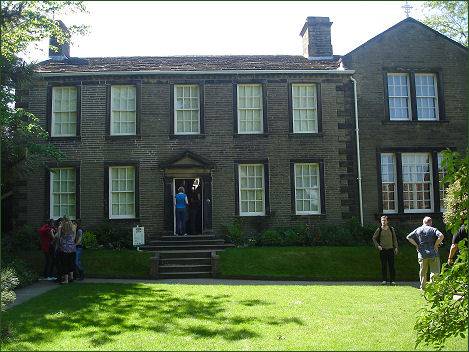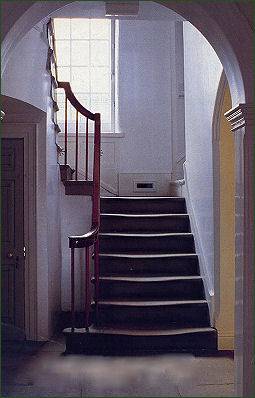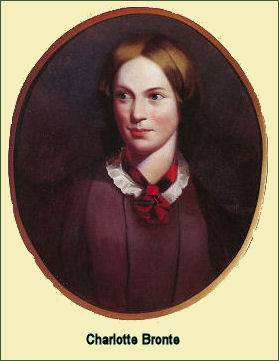The Bronte Parsonage Museum
OS grid reference:- SE 030 372
 The former home of the Bronte family, Haworth's Georgian parsonage is a museum to Britain's greatest literary family. The house contains period rooms containing original furnishings, and displays, paintings, books and manuscripts belonging to the Bronte family.
The former home of the Bronte family, Haworth's Georgian parsonage is a museum to Britain's greatest literary family. The house contains period rooms containing original furnishings, and displays, paintings, books and manuscripts belonging to the Bronte family.
 The Reverend Patrick Bronte, a native of Loughbrickland, County Down, accepted the perpetual curacy of Haworth in 1820 and arrived at the parsonage with his wife Maria Branwell and their family of six children, Maria (1813 or 1814-1825), Elizabeth (1815-1825), Charlotte (1816-1855), Patrick Branwell (1817-1848), Emily (1818-1848) and Anne (1820-1849).
The Reverend Patrick Bronte, a native of Loughbrickland, County Down, accepted the perpetual curacy of Haworth in 1820 and arrived at the parsonage with his wife Maria Branwell and their family of six children, Maria (1813 or 1814-1825), Elizabeth (1815-1825), Charlotte (1816-1855), Patrick Branwell (1817-1848), Emily (1818-1848) and Anne (1820-1849).
The parsonage at Haworth was to remain the family's home for the rest of their lives. The town of Haworth's moorland setting had a profound influence on the famous books of Charlotte, Emily and Anne Bronte.
Just the year after moving into the Parsonage at Haworth, on 15 September 1821, Maria Bronte died of uterine cancer. Her sister, the spinster Elizabeth Branwell, came from Penzance to help Patrick look after the children and to take over the running of the Bronte household.
In 1824 the four oldest sisters left Haworth, to receive an education at the Clergy Daughters' School at Cowan Bridge, near Kirkby Lonsdale. Tragicallly, Maria Bronte, described by Charlotte as lively and very sensitive, was sent home with an advanced case of tuberculosis and died at the parsonage in May 1825, at the age of eleven. Ten-year-old Elizabeth was returned home shortly after and died on 15 June.
Following several attempts to seek a new spouse, Patrick Bronte came to terms with widowhood at the age of 47, and spent his time visiting the sick and the poor, giving sermons, communion, and extreme unction. He left his three surving daughters Emily, Charlotte, Anne, and their brother Branwell alone with their aunt and a maid, Tabitha Aykroyd, known as Tabby, who liked to recount local legends in her Yorkshire dialect while preparing the meals.
 In 1846 Charlotte, Emily and Anne used part of their Aunt Branwell's legacy to finance the publication of their poems, concealing true identities under the pseudonyms Currer, Ellis and Acton Bell. The Poems was published by Aylott and Jones, but disappointingly, only two copies of the book were ever sold.
In 1846 Charlotte, Emily and Anne used part of their Aunt Branwell's legacy to finance the publication of their poems, concealing true identities under the pseudonyms Currer, Ellis and Acton Bell. The Poems was published by Aylott and Jones, but disappointingly, only two copies of the book were ever sold.
Charlotte's first attempt at writing a novel for publication, 'The Professor', was rejected by several publishing houses, before Smith, Elder & Co. declined to accept it but were encouraging enough for Charlotte to send them her next work, Jane Eyre.
Jane Eyre was published on 19 October 1847. Wuthering Heights and Agnes Grey had been accepted by the London publisher, Thomas Cautley Newby, and appeared as a three-volume set in December 1847.
After Anne's second novel, The Tenant of Wildfell Hall, Charlotte and Anne were forced to reveal their true identities.
Their brother Branwell, a painter and writer, was addicted to alcohol and opium, he developed tuberculosis and died suddenly on Sunday 24 September 1848, aged 31.
Emily was also dying from tuberculosis, never left the house after Branwell's funeral. She died aged of 30 on 19 December 1848. Anne too had tuberculosis. She was taken to Scarborough to try a sea cure but died four days after arriving there on 28 May 1849, aged 29 years. Charlotte finished the novel Shirley, begun before Branwell's death. It was published in October 1849. Charlotte's third novel, the last published in her lifetime, was Villette, which appeared in 1853.
Charlotte married her father's curate Arthur Bell Nicholls in Haworth Church on 29 June 1854. She died on 31 March 1855, in the early stages of pregnancy, three weeks before her 39th birthday. Charlotte was interred in the family vault in the Church of St Michael and All Angels at Haworth.
Patrick Brontė lived on at the parsonage for six more years, cared for by his son-in-law, and died there on 7 June 1861, at the age of 84.
Top Withens - said to be the inspiration for 'Wuthering Heights'
Historic Buildings of Yorkshire
